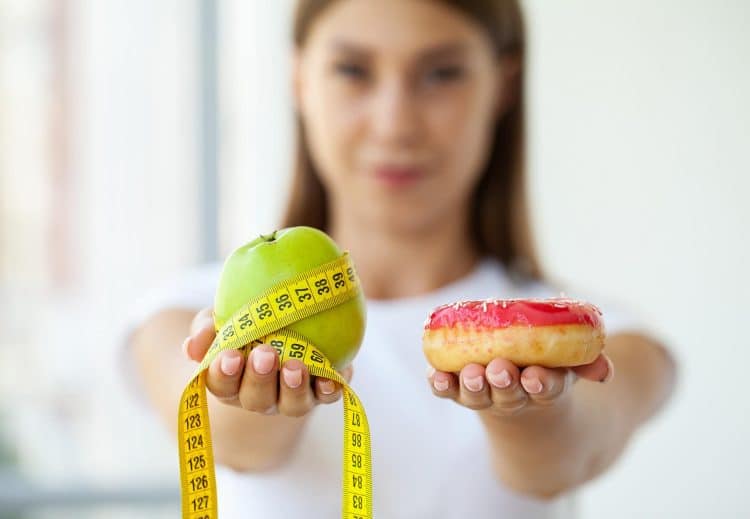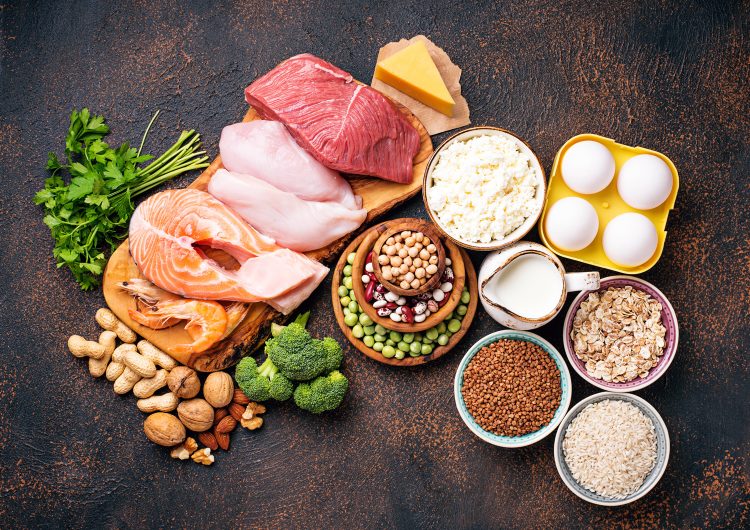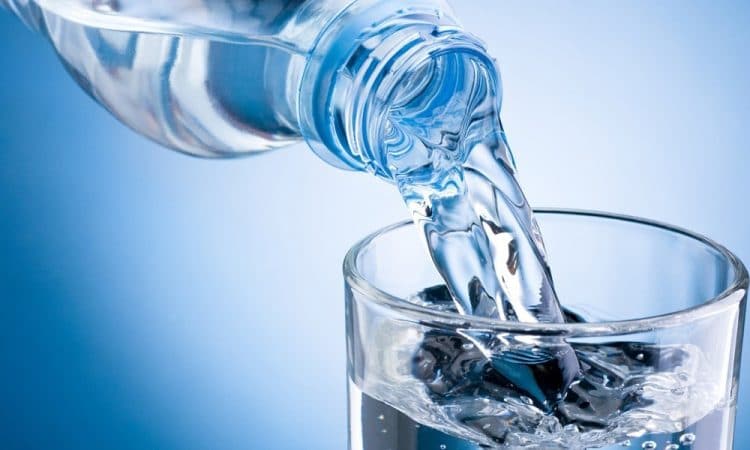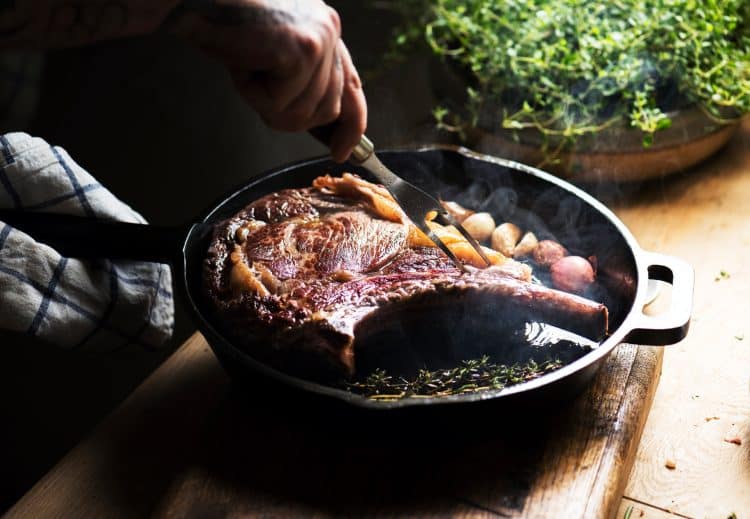Whether you want to lose weight, get ripped, build muscle, or improve your energy, you’ll probably need to change what you eat. For most people, this involves adopting a prescriptive diet that dictates what and when to eat and, more importantly, what you can’t eat.
There are hundreds if not thousands of diets to choose from, including:
- 5:2
- Body for Life
- Boiled egg
- Bulletproof
- Cabbage soup
- Dukan
- Intermittent fasting
- Keto
- Meal replacement
- Monotropic
- Paleo
- South Beach
- The Zone
- High Carb & Low Fat Diet
Providing your diet of choice meets your caloric needs, it will have the desired effect. For example, consume fewer calories than you need, and you’ll burn fat and lose weight, but consume more than you need, and you’ll gain weight – hopefully, mostly muscle mass if you are training hard.
However, it’s a sad fact that most people fail to stick with their diet long enough for it to work. They’re strong out of the gate but soon fall off the wagon and return to their previously sub-optimal eating plan.
That’s why so many of us lose weight only to regain it shortly afterward. Long-term, sustainable weight loss seems to be as rare as unicorns!
The good news is that healthy eating doesn’t have to be complicated or unpleasant, and weight management doesn’t have to take over your life.
You don’t even have to give up your favorite foods. However, you will need to quit looking for short-term fixes and adopt a few healthy, long-term habits.
In this article, we reveal how to fix your diet forever in six weeks!
- Why Most Diets Fail
-
Fix Your Diet Forever in Six Weeks
- Week 1 – Protein at Every Meal
- Week 2 – Plants at Every Meal
- Week 3 – Drink 64 Fluid Ounces of Water Per Day
- Week 4 – Pay Attention to Your Portion Sizes
- Week 5 – Remove Trigger Foods from Your Environment and Replace Them with Healthier Alternatives
-
Week 6 – Start Preparing and Cooking More of Your Own Meals
- 1. So, I don’t need to count calories?
- 2. How often can I cheat on this diet?
- 3. Is this a bulking or cutting diet plan?
- 4. What about bodybuilders and fitness models; they follow extreme diets and look amazing, so why can’t I?
- 5. What supplements should I take?
- 6. How do I lose that final few pounds/body fat percentage points?
- Fix Your Diet – Wrapping Up
- References:
Why Most Diets Fail
According to some frequently quoted statistics, as many as 95% of dieters fail to reach their body composition target or quickly backslide and regain the weight they lost once their diet is finished (1).
Because of this, a massive number of people are serial dieters who skip from one eating plan to the next in their quest for the best way to lose weight and keep it off.
The trouble is that all prescriptive diets work in much the same way, and while they may allow you to eat different foods, they all have the same failings. So it’s like eating vanilla ice cream one day and chocolate the next – the flavor is different, but the basic ingredients are the same. This is also true for diets.
Reasons that most diets don’t work include:
Too Restrictive
Most diets ban certain food or food groups. For example, paleo excludes all processed foods, while keto severely limits your carb intake. Others cut out sugar or alcohol. While cutting out certain foods can help contribute to your daily calorie deficit, it’s also guaranteed to trigger cravings and feelings of deprivation.
For example, being told you won’t be able to eat bread for a month is almost guaranteed to leave you drooling at the thought of some dinner rolls, even if you didn’t eat a lot of bread before.
Any diet that bans a particular food or food group will invariably result in cravings. In most cases, cravings will drive you to cheat on your diet.
Too Complicated
The moment anything becomes more trouble than it’s worth, most people stop doing it. But, to make them unique, many diets are unnecessarily complicated. This complexity makes it appear as though there is some kind of secret code to weight loss and healthy eating when no such thing exists.
Food combing diets are a perfect example of this. Some may say things like “you can’t eat fat and carbs in the same meal,” which looks okay on paper but makes meal prep far more complicated than it needs to be.
Ultimately, for any diet to work, it needs to be simple enough to follow every day; you’ll soon quit if your diet becomes a hassle.
Too Expensive
Food is one of life’s unavoidable expenses, and some foods are more expensive than others. For example, some diets specify that you must eat expensive foods and that somehow these products are better for weight loss than those that are more reasonably priced.
Organic vegetables and grass-fed beef from free-roaming cattle cost a lot more than the basics you get at Costco but nutritionally are not all that different. They certainly won’t help you lose weight faster.
For a diet to be sustainable, you need to be comfortable with how much your food costs. For example, if your grocery bill doubles overnight, you’ve got a readymade excuse for quitting your new eating plan.
It’s also worth remembering that healthy eating does not have to be expensive. In fact, in many cases, things like fruits, vegetables, lean proteins, and whole grains are actually very cheap, especially when you buy them in bulk.
Perfection or Bust
Diets are often so prescriptive that they allow no variation. It’s “our way or the highway!” However, real life has a way of making any diet hard to stick to, and when you deviate, you may end up thinking that you’ve failed, so you might as well quit for good.
Food is one of life’s pleasures, and you should not feel like a failure just because you went out for dinner and had an unplanned dessert! The reality is that your diet doesn’t have to be perfect. It just needs to be pretty good most of the time. Pretty good is more than enough to reach all but the loftiest body composition goals and 90% better than how most people eat.
Not Made for Long-term Use
Many diets are advertised with sales spiel like “lose 30 pounds in 90 days” or “30-day get ripped plan.” Putting a timeframe on any diet sets you up for failure.
Excess body fat accumulates over many years. No one goes to bed lean and then wakes up fat! Achieving your body composition goal could take many months and even years. To achieve a significant result in just a few weeks, any diet MUST be very restrictive and, therefore, it’ll be unsustainable.
Look at any diet and ask yourself, “can I follow it for the next 6-12 months.” If you can’t see that happening, you should forget about it and seek a better, more sustainable plan, like the one we’re about to reveal in this article!
Too Much Hunger
Being hungry is no joke. If you are hungry, you’ll start to obsess about food, and you’ll have to use your willpower to avoid cheating on your diet.
Unfortunately, willpower is a limited resource, and if you demand too much of it for too long, eventually it’ll run out, and you’ll have no choice but to give in to your hunger.
Based on Flawed (or no) Science
Some diets are based on very flawed science or may not be based on any science at all. One example of this is calorie-burning or negative calorie foods. No food burns more calories than it contains, and such claims are very misleading. If a diet promises something that sounds too good to be true, it probably is, so don’t fall for it.
Effective diets work by manipulating your calorie balanced. Consume fewer calories, and your body will make up the shortfall by using stored body fat for energy. No deficit means no fat burning. There are no shortcuts around this law of thermodynamics.
Fix Your Diet Forever in Six Weeks
So, you know should now understand why so many diets fail to live up to their promises. They’re unsustainable, impractical, expensive, or just more trouble than they’re worth.
Don’t just try another diet that’s bound to fail. Instead, it’s time to gradually overhaul your diet and replace short-term fixes with some long-term healthy eating habits.
By making smaller changes over several weeks, you won’t have to use your willpower to overcome hunger or cravings and won’t feel like you need to quit. And, to make the process easier, you’re only going to change one thing per week.
Just keep your current diet the same, and week by week, make these small but impactful changes. Maintain each change the following week so that, by the end of the six-week period, you have entirely but gradually overhauled your diet, i.e.,
- Week 1
- Week 1 and 2
- Week 1, 2 and 3
- Week 1, 2, 3 and 4
- Week 1, 2, 3, 4 and 5
- Week 1, 2, 3, 4, 5 and 6
Week 1 – Protein at Every Meal
Protein is a bonafide superfood. It’s critical for muscle growth and repair, highly satiating (filling), and even boosts your metabolism. And yet, despite being such a powerful macronutrient, many people fail to eat enough.
So, for your first week, all you need to do is start eating protein at every meal. It doesn’t matter what protein source you choose, so long as you eat protein at least three times per day.
Options include but are not limited to:
Remember, you don’t need to change anything else about your diet other than make sure you consume protein at every meal. For extra merit points, you can eat some high-protein snacks, too.
Go the extra mile by making sure you are consuming enough protein for your training goal. However, initially, just focus on eating protein at every meal.
Week 2 – Plants at Every Meal
Most people eat a lot of processed foods. While these foods are very convenient, they’re also low in vitamins, minerals, and fiber. And that’s where plant foods come in. Fruits, vegetables, whole grains, nuts, seeds, etc., are very nutritious and generally low in calories.
So, for week two, try to eat some kind of plant food with every meal. Have a side of veggies with your dinner, an apple or banana with your lunchtime sandwich, or toss some berries on your breakfast cereal.
Week 3 – Drink 64 Fluid Ounces of Water Per Day
Your body is made up of about 60% water. Water is used to transport chemicals and nutrients around your body, regulate your temperature, for lubrication, and a host of other critical physiological functions.
And yet, despite this obvious importance, many people are chronically dehydrated and quench their thirst with soda, fruit juice, and other unhealthy beverages. So, for week three, your mission is to drink 64 fluid ounces of water per day. That’s plain water and is in addition to any other beverages you consume.
Keep track of your water consumption by buying a reusable 32-ounce bottle and filling it in the morning. Drink the contents gradually over several hours and then refill it and drink the remaining 32 ounces during the latter part of your day.
Staying hydrated will help flush toxins from your body and may also reduce hunger and cravings.
Week 4 – Pay Attention to Your Portion Sizes
Depending on your body composition goals, you may need to eat less or consume more calories. Start paying attention to how much you eat. Note how you feel immediately after your meals, and then adjust the size of each meal according to how hungry you feel.
Because you are eating more protein, plant foods, and drinking more water, you may find that you feel fuller than before and don’t need to eat as much. You could also find that you feel hungrier after exercise but less hungry on days you are not so active.
While you probably don’t need to count calories, you should start adjusting your food intake based on your hunger and energy levels. With practice, you’ll be able to instinctively adapt your food intake to match your energy expenditure and fitness goals.
Week 5 – Remove Trigger Foods from Your Environment and Replace Them with Healthier Alternatives
After four weeks of adding things to your diet, it’s time to distance yourself from any less-healthy foods you know you cannot eat in moderate amounts. That could be cookies, potato chips, ice cream, or any other food you cannot eat occasionally and in small quantities. Most people have at least one trigger food – it’s something you just can’t say no to.
This does not mean you have to give these foods up; just that you should put them well beyond reach, so you have to work a little harder to eat them.
For example, if cookies are your weakness, remove all the cookies from your home, make sure you don’t have any in your desk drawer at work, take those emergency cookies from your car’s glove box, and don’t buy more when you next go to the store.
This strategy aims to make eating your trigger foods more inconvenient. You can still eat things like cookies, candy, chocolate, etc., but you’ll need to make a special trip to buy them rather than just grab them from your handy junk food stash.
In many cases, this inconvenience will be enough to stop you from eating junk food. It’ll be more trouble than it’s worth to jump in your car and drive to the store just to buy a sweet or savory treat.
If you are actually hungry, just eat an apple, some nuts, beef jerky, or one of the healthier alternatives you bought instead. You may even realize you aren’t really hungry at all and wanted a cookie for emotional rather than physical reasons.
Week 6 – Start Preparing and Cooking More of Your Own Meals
The easiest way to control what you eat is to make it yourself. Cooking is a skill and can be time-consuming, which is why this week’s task specifies, “start preparing and cooking your own meals.”
Begin by making a few healthy breakfasts and get into the habit of starting your day with a healthy meal. Overnight oats are a great option, as are smoothies, eggs, fruit, or yogurt. Just try and cut down and eventually quit sugary cereals.
Next, start making a few of your own dinners. Grill some meat, steam some veggies, and have some rice, potatoes, or pasta on the side, and you’ve got a healthy meal that’ll be ready in less than 30 minutes.
Once you’ve developed the habit of eating a healthy breakfast and dinner most days, turn your attention to your lunch.
Gradually, over the next few weeks, prepare more and more of your own meals until you are almost only eating food you have made yourself.
That’s not to say you can’t have a takeout pizza now and then or that readymade meals are entirely off the menu. If you prepare healthy meals 90% of the time, you buy yourself some dietary latitude and can afford to eat some less nutritious food when you want it. Doing so will help keep you sane and means no foods are off limits, so you won’t experience so many cravings.
FAQs
This gradual approach to changing your diet for good is tried and tested and very straightforward. By making small changes over several weeks, you ease yourself into a sensible, sustainable, and healthy diet instead of trying to change everything at once with a crash diet that sets you up to fail.
However, we understand that you may still have questions, so we’ll try and answer them below. Feel free to post any unanswered questions in the comments section.
1. So, I don’t need to count calories?
People have maintained a healthy weight and body composition for hundreds of years without counting calories. Use your hunger and weight to determine if you are eating too much or not enough.
If you want to lose fat and aren’t, reduce the size of your portions. If you are trying to build muscle and aren’t, increase the size of your portions.
Don’t rely on an app to tell you how much you should eat. Instead, use your body and brain and learn how to adjust your food intake yourself.
2. How often can I cheat on this diet?
Whenever you want! If you feel like you deserve a cheat, then have one. However, understand that the more you cheat, the slower your progress will be. And stop thinking of foods as good or bad.
You can lose weight and burn fat eating unhealthfully and gain weight eating healthily. The calorie content is what counts most in weight management, and you can even lose weight if you eat a lot of sugar (2).
That said, it goes without saying that unprocessed, natural foods are better for your health. Because they’re lower in calories, you can eat a greater volume than processed foods.
Related: 7 Ways to Stop Cheat Meals Ruining Your Diet
3. Is this a bulking or cutting diet plan?
Neither! Both!
Your calorie intake determines whether an eating plan will help you build muscle or cut fat. For example, if you have a calorie deficit, i.e., consume fewer calories than your Total Daily Energy Expenditure or TDEE, your body will burn fat for fuel. But on the other hand, if you consume more calories than your TDEE, your body can use those extra calories for muscle repair and growth.
So, adjust portion size based on your body composition goals rather than change your diet for bulking or cutting.
4. What about bodybuilders and fitness models; they follow extreme diets and look amazing, so why can’t I?
While bodybuilders and fitness models often follow extreme diets, they usually only do so for a few weeks a year to get in the best shape possible for a show or photoshoot. The rest of the time, they maintain their physiques with a more moderate diet like the one outlined above.
This is called peaking, and most figure and physique athletes only maintain peak condition for very short periods. We’re talking hours and days, and not weeks.
That’s because even a pro-card-carrying bodybuilder can’t maintain ultra-low body fat levels for long; it’s just not sustainable.
So, if you try an extreme diet, just remember that it’s not meant for long-term use. You’ll need to revert to a more sustainable eating plan afterward, during which you will experience some unavoidable fat regain.
5. What supplements should I take?
You don’t need to use any supplements if you don’t want to. That said, you may get some benefits from protein powder, which makes including protein in each meal much easier. Creatine is also helpful and is a proven muscle builder and performance enhancer. Pre-workouts can be useful if you need extra energy for your workouts.
However, in terms of calories and nutrients, you should be able to get everything you need from your diet. If you do use supplements, think of them as add-ons to and not replacements for your new, healthy long-term diet plan.
6. How do I lose that final few pounds/body fat percentage points?
Incorporating the six guidelines above should help you drop any unwanted pounds and get leaner. But, if you want to get REALLY lean, you may have to tighten up your diet a little more for a few weeks and double down on your workouts.
Use a calorie calculator to determine your TDEE. Then make sure you consume 300-500 calories below that number, so you are in a calorie deficit. Also, increase your daily calorie expenditure by walking as much as possible and adopting more intense forms of training, such as HIIT and circuit weight training.
Plan on following this hardcore approach for no more than 4-8 weeks. Then, afterward, gradually transition back to your sustainable “off-season” diet.
Fix Your Diet – Wrapping Up
Eating healthily does not have to be complicated, unpleasant, or expensive. Whether you want to lose fat, build muscle, or improve your performance, a sustainable diet is the way to go.
This plan is designed to improve your diet gradually over six weeks by changing just one eating habit at a time. These small changes will add up and completely transform your diet, as well as change your view of dieting and food.
While such a gradual approach will not produce rapid results, you are more likely to be able to stick to it and won’t have you use your willpower as much. A slow and steady program you can stick to will always be better than an extreme program you can only follow for a few days.
So, ditch those drastic diets and adopt a more conservative approach to weight management. Make your next diet your last one with this six-week nutrition transformation.
References:
1. American Journal of Clinical Nutrition: Long-Term Weight Loss Maintenance https://academic.oup.com
2. PubMed: Weight loss in overweight subjects following low-sucrose or sucrose-containing diets https://pubmed.ncbi.nlm.nih.gov/11477496/


















Great advice. Most diets suck – this is a much more logical, sustainable approach to healthy eating. Thanks!
Thanks for the feedback – hope it works well for you.